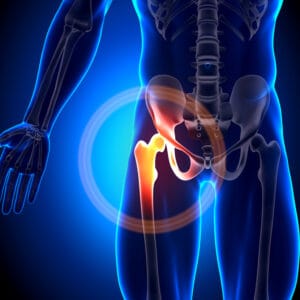Femoral acetabular impingement occurs at the hip joint. Medically, the hip joint is comprised of the acetabulum (hip socket) and the head of the femur (hip bone). Between these two bones are two types of tissue called cartilage. Articular cartilage lines the bones and is used to decrease friction between the bones, and a stronger cartilage called the labrum helps to deepen the hip socket to increase stability.

With femoral acetabular impingement the hip joint can pinch on different structures in the hip joint such as the labrum and articular cartilage, and cause pain. This can either be caused by the inherited shape of the bones involved in this joint, previous injury to the hip, or overuse of the musculature surrounding the hip joint.
The pain with femoral acetabular impingement is usually described as deep pain localized to the front of the hip and into the groin. Activities that can increase the pain can be prolonged sitting, standing, walking, and sports specific activities such as rotation and pivoting. There may also be pain when the hip is in specific positions of hip flexion, adduction, and internal rotation (bringing your knee to your opposite shoulder). There may also be clicking or giving way felt at the hip.
Femoral acetabular impingement is more common in people who relate to the following:
- young adults
- athletic populations
- tight or weak muscles around the hip
- decreased range of motion of the back
- difficulty getting into a deep squat or using the stairs
- walk at a slower pace with a smaller step length
What are the treatment options for Femoral acetabular impingement?
A physiotherapist will conduct a thorough examination of the person to ensure a proper diagnosis is obtained. This will include getting a detailed history, examining the area of pain, and performing specific tests to determine the root cause of the pain. Following the examination, an individualized treatment plan will be made to help you achieve your goals and assist you on your road to recovery.
If you are experiencing pain at this joint a physiotherapist will work to decrease your pain through increasing your back and hip range of motion. In addition to this they would work on increasing the strength of your hip muscles through specific exercises.
If you think you may have femoral acetabular impingement, contact us to book an appointment with one of our physiotherapists today!

